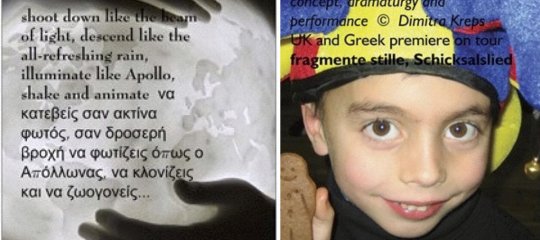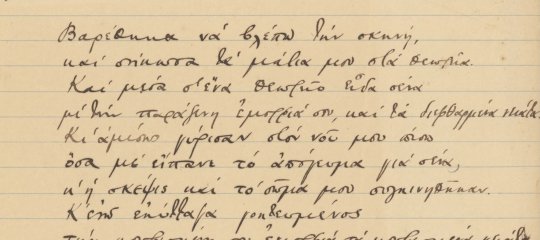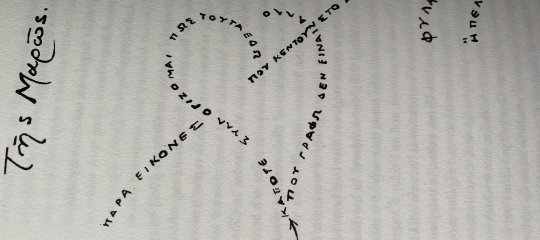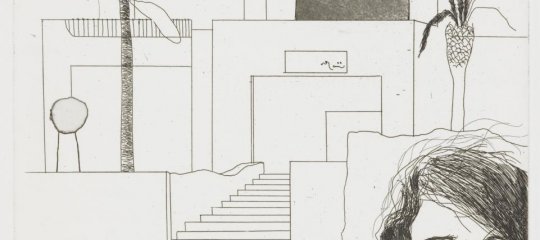Introduction to Modern Greek Literature (Cavafy)
tzanidaki writes, "Ergasia tis Gemma Lock, 2etous foititrias sto mathima:
Introduction to Modern Greek Literature
Lecturer: Dr Dimitra Tzanidaki-Kreps, University of Reading, Department of Classics
"
22 Απριλίου 2008
Discuss how Cavafy subverts historical validity shedding his own poetic light on history and its events.
Cavafy uses history and its events as a subject for much of his poems’ content. In Robert Liddell’s Cavafy: A biography, he highlights an aptitude for writing history expressed by the poet himself, stating in an interview that “I ask myself…‘Cavafy, could you write History?’ A hundred and twenty five voices tell me ‘You could’.” Liddell describes an avid interest in and vast knowledge of certain periods of history (he had read and annotated Gibbon ). Upon closer examination, however, it becomes obvious that rather than merely writing ‘history’ he writes of history. He adopted three categories in which to describe his work: erotic, philosophical, and historical , though it would be misleading to suggest that his work could be divided in such simplistic terms. No one in any of the one hundred and fifty-four poems of his Canon fits solely into one of the three thematic categories; they all contain thematic crossovers (Caesarion for example, known for both its historical references and gentle eroticism). I propose that he writes of history with the skill of a poet rather than a historian; he goes beyond the regimented facts of history and exposes beauty, revealing the essence of the event’s meaning by making clear its significance. Epstein describes this notion of “poet’s history” best:
“The historian’s function, in this view, is to show what happened in history; the poet’s is to make plain its significance”.
Despite this concern for poetic significance, he was particular about detail and accuracy, and so highlighted and manipulated choice history rather than simply eradicating its validity. In further analysis of the question I will structure my discussion by first looking at what he does in his poetry to subvert historical validity, and then examine the techniques he applies in order to do these things. I maintain, throughout, my proposal that when he writes of history it is from the perspective of an artist and a poet.
When examining the poetic intention behind Cavafy’s poetry it is important to observe the potential influence that literary movements and historical context might have on his personal attitudes and approaches to his poetry. According to Mackridge in his review of Jusdanis’s book, The Poetics of Cavafy: Textuality, Eroticism, History, the development of Cavafy’s poetry owes a debt to the European cultural currents of his contemporaries, with particular regard to the movements of Decadence, Aestheticism, French Symbolism and Parnassianism. Mackridge suggests that “the Parnassian’s detached contemplation of the past served as a model for Cavafy’s attitude in many of his [early] ‘historical’ poems”. As he largely abandoned these models in favour of his own distinctive style early in his career, in light of this particular essay it is not relevant to examine these currents in great depth, however there is a degree of interest in some of the scholarly speculation surrounding them, specifically that of Robinson, who accounts much of Cavafy’s early influence to the Decadent movement. He details Decadent attitudes and acknowledges their existence in Cavafy, most interestingly an assessment of life (according to Robinson shared by the influential Decadent and Symbolist poet, Baudelaire) as “stretches of mindless monotony broken by brief but intense sensations which momentarily bring us to life.” I concede that there is evidence amongst Cavafy’s poetry in support of this theory, and find that, whether through developmental influence (in accordance with Robinson) or by coincidence, there are elements of this view amidst his work. Caesarion embodies this view perfectly: Cavafy, having picked a character that is a mere footnote in history, is able to bring him to life through the eternal power of poetry, rescuing him from the monotony of anonymity. In further reflection of this view, it can be said in the poem that, despite reading to alleviate his boredom, the more he reads the Ptolemaic inscriptions the more bored he becomes, only finding release from the monotony of the generic grandiosity of historic certainty when happening upon “a small insignificant mention of King Caesarion”. It is his historical insignificance that enables Cavafy to create beauty, and salvage both himself as a character in the poem, and us as readers, from our monotonous daily existence. Throughout his poetry in general he attempts to transcend the mundane experiences of everyday life by undermining historical truth in order to reveal its beauty, and so the subversion of historical validity in order to expose a poetic perspective can be said to be in congruence with the Decadent life view.
Aside from its possible parallel with Robinson’s theory, Caesarion exemplifies Cavafy’s preference for the underdog; failing or ill-fated characters (whom Beaton refers to as “the losers” ), nations in decline (e.g. the Spartans in Come, O king of the Lacedaemonians), and unstable political situations (e.g. the outcome of the Battle of Actium in In Alexandria, 31B.C.). The poet as a character in Caesarion explains that it is precisely the fact that Caesarion is insignificant in history that makes him the perfect candidate for his poetry:
“In History only
a few lines are dedicated to you,
and thus I could form you more freely in my mind.”
It gives Cavafy the freedom to fashion him into an object of beauty to suit his poetic purpose; the glorious, well established characters of history cannot be artistically recreated in this way as their historical fact is clear. He is self-referential, employing the poetic ego to show his control over Caesarion as he reiterates “thus I could form you”. He also establishes a sympathetic view of Caesarion, his pathos all the more tragic having been portrayed with such a delicate, sorrowful beauty. Perhaps Cavafy demonstrates this preference in order to “humanise the past” , subverting history to bring relevance to the audience of the present, and present his poetry on a more accessibly human level:
“...disintegration and defeat reveal the multiplicity of human reactions to adversity and the relativity of all human activity.”
He purposefully picks out defeat and decay in order to be able to recapture the glory of the character or event, or to highlight its pathos and expose its relevance to humankind. In either case, his skill lies in careful manipulation of history, forming a new poetic perspective.
This sympathy with the victims of history goes further, as Cavafy uses his poetry as a device through which to redeem characters and resurrect lost people. He chooses to resurrect Caesarion in both Caesarion and Alexandrian Kings, in the latter approaching the tragedy with art and beauty by representing him through physical aesthetic description. In this way, his poetry materialises as an ‘antidote to decay’, transcending the limits of time so that the character will now eternally remain “Caesarion full of grace and beauty”. A catharsis is reached through both the redemption of the character and through the power of poetic art itself, whereby he elevates all (Caesarion, himself, and all mankind) from monotony through the granting of aesthetic significance. Not only does he redeem his choice characters, but he also uses them to help salvage lost people relevant to the present world. Caesarion can be juxtaposed against an event contemporary to its creation, where a seventeen year old boy had been executed after coming into conflict with a military presence who had murdered a woman and child in an attack on his village. Cavafy wishes to redeem both young lives lost for nothing, mere sacrifices to power play, their deaths all the more tragic for their youth. Both characters emerge as restored figures, and through the art of the poet are immortalised:
“…with the aid of his historical precision and his refusal of undue emphasis or over-dramatization, Cavafy can take a small historical incident, or even a person of tertiary significance, and raise it or him to an impressive general significance.”
The role of memory and time are particularly important in Cavafy’s poetics as methods for reanimating the past and regaining time. Whether by intentional invocation or by some kind of trigger, memory is used as a mediating force for recalling a character or an event in order that it may transcend time and become immortalised in poetry. Cavafy makes use of this technique in various facets of his poetry, but in terms of its use in a historical scenario, he applies it to provide an alternative presentation of history to the established one, subverting the historically accepted view and revealing a subjective reinterpretation based on the point of view of an individual, and potentially biased, account. This account can be given from the biased emotions and thoughts of historically significant characters (King Demetrius in The displeasure of the Seleucid) or from the memories or observations of a narrator character, reviving the past from a subjective perspective, not necessarily the poets own. We have seen this kind of revivification of the past in Caesarion before in this discussion; the narrator invites the readers to share in his memory of his sensual recreation of Caesarion as an ideal victim, personifying him through the freedom of poetic imagination. Robinson describes him as part of personal time, a “succession of actions which pass and are lost” , and historical time, placing the power of poetic imagination as a key to Cavafy’s redemptive skills. The divisions of time disappear as the past converges with the eternal present of the imagination regaining lost individuality: the conflict between past and present, history and imagination is resolved.
Cavafy employs various important techniques in order to subvert historical validity in his poetry, the first of which is the personification of historical figures that we know very little about, personalising and individualising characters that have been reduced to names in the reporting of history. He imbues characters with detailed personal qualities or meticulously described aesthetics despite having no possible access to this level of knowledge of their genuine counterparts. In order to expose their story from his point of view (or at least an alternative, subjective one) he reclaims them from history and recreates them, breathing life into them with poetic imagination. In Come, O king of the Lacedaemonians, Cavafy takes the character of King Cleomenes’ mother, Cratisicleia, and brings her to life in the poem. She is about to leave Sparta in order to be held hostage in Egypt under Ptolemy III, and accepts her fate bravely with typically Spartan spirit. In order to portray this he lends her a “majestic dignity” , describing her as “that wonderful woman” and attributing to her a strong sense of pride associated with her Spartan royal heritage:
“Cratisicleia felt it beneath her to be seen
by the people crying and lamenting…
Her imperturbable countenance displayed none
of her consuming pains and sufferings.”
He goes further to depict her as a loving mother, showing her son motherly affection as “she embraced him and kept kissing him” . In a display of Cavafian inter-textuality, he identically restores her in his related poem In Sparta, and makes clear the intentions of her favourable portrayal:
“As for the humiliation – well, she couldn’t care less.
A Lagid, a king of only yesterday, was of course
unable to grasp the Spartan spirit;”
In order to show history from a Spartan perspective (at this point a nation aware of its decline) highlighting the relative inferiority of the Egyptian King, the queen must be presented in sympathetic manner. This detailed characterisation of a person who has been reduced to a two dimensional figure in history in order to aid the creation of a subjective perspective is typical of Cavafy, clearly working here as a poet rather than a historian.
In a similarly subversive technique, Cavafy sometimes presents his readers with imaginary characters or events set within real historical situations in order to expose a specific perspective. This can be seen in the example of On the march to Sinope, where an imaginary seer is met by the official of King Mithridates V (later murdered by his wife) whom he warns to abandon his greedy expansionist policies:
“…the king ought to content himself
with what he has; anything more will lead him into danger...
Fate is fraught with sudden twists.”
This imaginary scenario is an effective way of recreating the political ambience of the authentic time period and the characters it concerns, retelling Mithridates’ story through the clever reference alluded to by the seer. The invented character of the seer acts as a vehicle for Cavafy’s reference to an even more distant past, an allusion to a companion (King Demetrius) of his ancestor (Mithridates II) who:
“…in the nick of time traced in the dust
of the road, with his spear, the life-saving words: flee Mithridates.”
It is both a complex reference of history within history, and a warning against greed, which, with typical Cavafian irony, is what ultimately causes his death. Inventing a character and/or an event in such a way serves the poet as a method by which he can write poetically and imaginatively about genuine history, and recreate a subjective historical perspective in a poetically creative way without falsifying history. This technique is neatly exemplified in the poem In Alexandria, 31 BC, where the cover-up of Antony’s defeat at Actium is viewed from the point of view of an imaginary character of ‘the peddler’. The scene and character give body to the perspective Cavafy wishes to reveal, using poetics to allow him creative control.
Cavafy’s selection of history and his presentation of it is extremely measured and carefully considered. He does not wish to act as a historian and catalogue or report history in an objective manner; rather he provides a “selective re-creation of history” , showing us choice snippets, acting almost in the same way as propaganda, offering us a subjective perspective. Keeley’s explanation of this technique offers, I think, a perfect summation of its uses:
“This is not to suggest that Cavafy distorts history at will for poetic purposes…His mode is not to alter the essential substance…or offer entirely arbitrary interpretations, but rather to select and highlight that which is both true to his view of the historical moment and relevant to the particular ideology…also to search behind the obvious, established implications of familiar history for those sometimes hidden meanings and attitudes”.
He selects what samples of history to reveal to us in a way that best befits his chosen ideology, and allows relevance to the present, exploring the historical precedents to his own culture and in so doing, defining ours.
Selection of which moments and events to depict is very important, and thus, in a similar way, he selects his presentation of history very carefully. Each poem is attentively ‘stage managed’; Cavafy controls and filters all elements of the portrayal whilst ensuring he retains the essence of the historical event. Alexandrian Kings is a prime example of this ‘stage managing’ of historical events. The poem details the spectacle staged by Antony, having invested his children with kingly titles. Antony and Cleopatra, seemingly integral protagonists as instigators of the event (as represented in Plutarch) , are completely ignored (Cleopatra is mentioned once) , choosing to focus on the nature of the spectacle and the character of Caesarion (whose appearance is the only one of the children’s neglected by Plutarch) . It would seem that he has used Plutarch to fashion an alternative perspective, and “slants, or extends, or re-creates selective aspects of historical sources so as to permit his own interpretation of the material…” This usage of historical sources, particularly the cutting and splicing of them into, or as a prelude to, his poetry, is commonplace. King Demetrius opens with an extract of Plutarch which relates directly to his portrayal in the poem. The technique contributes to the creation of the desired subjective viewpoint, exposing the relativity of historical ‘truth’.
I conclude that whilst Cavafy writes about specific events or people in history, his primary concern is not with the reporting of impartial history, but rather with subverting it, without losing its accuracy, in order to reveal an emotive, poetic perspective to the content of the poem. He redeems and revivifies selected elements of the past, in order to bring the past to life in the present, and illustrate a specific viewpoint (be it a subjective one or that of his own) that illustrates the significance of the event. It is in this significance that we find the meaning of the poem, Cavafy having successfully created beauty from the mundane, whilst remaining accurate in detail to the history he has described. In this way, he subverts historical validity and sheds his own poetic light on history and its events; he maintains his integrity in writing history whilst subverting it, and triumphs as a poet, approaching his work not with the restrictive focus of a historian, but with the skill and intention of a poet.
Word Count: 2,788 Words
Bibliography:
Primary Literature:
C.P. Cavafy: The Collected Poems, translated by Evangelos Sachperoglou, Oxford World Classics (2007)
Alexandrian Kings (p53)
Caesarion (p85)
Come, O king of the Lacedaemonians (p195)
In Alexandria, 31 B.C. (p149)
In Sparta (p175)
King Demetrius (p43)
On the march to Sinopi (p185)
The displeasure of the Seleucid (p47)
Plutarch, Life of Antony 54 - http://www.perseus.tufts.edu/cgi-bin/ptext?lookup=Plut.+Ant.+54
Plutarch, Life of Demetrius 44 - http://www.attalus.org/old/demetrius2.html
Secondary Literature:
W. Barnstone (1977) ‘Real and Imaginary History in Borges and Cavafy’, Comparative Literature 29: 54-73
R. Beaton (1999 – Revised 2nd Edition) An Introduction to Modern Greek Literature (Oxford)
J. Epstein (1994) ‘C. P. Cavafy, a Poet in History’, The New Criterion 12:5: 15-22
E. Keeley (1996) Cavafy’s Alexandria (West Sussex)
R. Liddell (1974) Cavafy: A Biography (London)
P. Mackridge (2007) ‘Introduction’, C. P. Cavafy: The Collected Poems (Oxford) xi-xxxiii
P. Mackridge, ‘Review of G. Jusdanis, The Poetics of Cavafy: Textuality, Eroticism, History’ (Princeton, 1987) in Comparative Literature 43 (1991) 288-290
C. Robinson (1988) Studies in Modern Greek: C. P. Cavafy (Bristol)
- Εισέλθετε στο σύστημα για να υποβάλετε σχόλια










